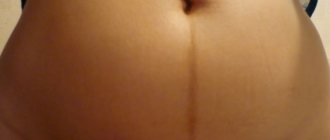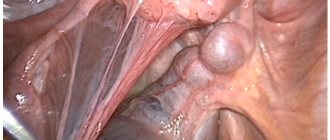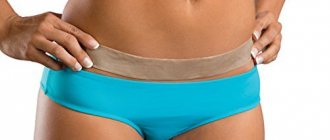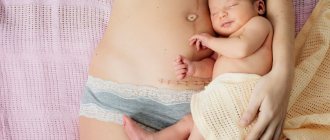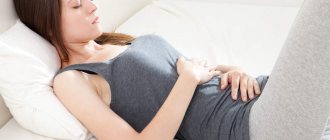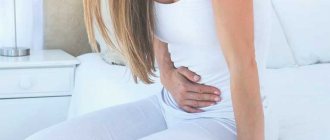Childbirth in women does not always occur naturally. There are often situations in which doctors are forced to resort to caesarean section. The operation is quite complex, requiring some time for the woman to fully recover.
As experts note, girls after a cesarean section have slightly more problems than women who gave birth naturally. In addition to the painful suture, there are added difficulties with defecation. Constipation can not only disturb a woman’s emotional background, but also cause poisoning of the body.
How many days have you been constipated?
3-4 daysmore than 5
Let's look at how to properly cope with constipation after a cesarean section with the help of drug therapy and proper nutrition.
Why are there problems with stool after cesarean section?
Problems with bowel movements after cesarean section in women are quite common. And the reason is not always nutrition. It's all about the anatomy of the intestine.
Let's look at the most common factors that lead to constipation after cesarean section:
- Psychological fear of harming yourself (possibility of seams coming apart). In this case, the woman is afraid to push. Feces cannot pass out. This leads to constipation. Solving the problem is quite simple. It is important that the doctor in the postoperative period explains to the woman how to go to the toilet correctly. At first, microenemas can greatly facilitate the task. They have a gentle effect on the intestines, softening stool.
- Physiological changes in the intestine. If the fetus is large, but in the last stages the uterus puts significant pressure on the intestines, the normal process of food digestion is disrupted. After birth, it will take time for peristalsis to return to normal. At the initial stage, special suppositories and other medications prescribed by a doctor can help.
- Poor nutrition. After abdominal surgery, a woman must follow a special diet. It lies in the fact that the foods consumed should not cause gas formation and should be easy to digest. Women themselves note that caring for a baby takes a lot of time, so they have to forget about proper nutrition. Snacking on sandwiches and snacks often occurs, which leads to constipation.
- Stool after cesarean section may change due to the fact that the gastrointestinal tract is slowed down. This phenomenon is not uncommon; literally 2-4 days after abdominal surgery everything will return to normal.
- The occurrence of hemorrhoids. This phenomenon is quite common among women in labor. In addition to difficulty defecating, the woman experiences bloody stool and bleeding in the anus.
- Cracks in the intestines. In this case, the stool may be black with an admixture of blood threads. In most cases, surgical intervention is not possible.
- Insufficient amount of fluid drunk. Maintaining water balance is an important point. Women after a caesarean section should drink at least 2 liters of water per day. This will not only improve intestinal motility, but also increase the amount of milk in a nursing mother.
It is important! Many women may experience green stool after a caesarean section. Doctors assure that during the first 2 days this is the norm. The effect of drugs and anesthesia on the intestines. If after this time the color of the stool has not changed, you need to take a culture test to rule out dysbacteriosis and other problems with the gastrointestinal tract.
Exercise to prevent constipation
Exercise to combat constipation
If you experience constipation after childbirth, do not rush to use medications, try a few simple and safe exercises. Perhaps this will solve your problem.
- Drink a glass of water at room temperature. After a quarter of an hour, you should do 10 squats, then squat for 20 seconds, then stretch your legs and squat about 5 times. This exercise helps to quickly cleanse the intestines. If the result does not follow, drink another 2-3 glasses and repeat the exercise.
- Feet shoulder-width apart, hands on the belt, tilt the body back, then lean forward until a right angle is formed, and straighten again. This is how we train the lumbar muscles and activate the intestines.
- With your back against the wall and your feet shoulder-width apart, clasp your hands at the back of your head. After taking a deep breath, try to push your stomach out strongly, and when you exhale, pull it in. This load trains the diaphragm and abdominal breathing, improving intestinal motility and blood circulation in the abdominal cavity. By the way, deep breaths always stimulate contraction of the walls of the gastrointestinal tract.
- With your hands on your waist and your feet shoulder-width apart, slowly lean first to the left and then to the right.
- Take the following starting position - your legs should be slightly wider than your shoulders. Lean your body back slightly and immediately lean forward. At the same time, try to reach the floor with your hands. Thus, you will train the muscle tissue of the back, which will contribute to better outflow of venous blood from the gastrointestinal tract.
- Stretch your arms to the sides and place your feet shoulder-width apart. As you bend forward, reach your opposite foot with your fingers. Such activities have a direct effect on colon motility.
- Place your feet shoulder-width apart and spread your arms out to the sides. Alternately rotate your torso to the right and left. This exercise normalizes intestinal motility.
- Sitting on a chair and turning sideways to its back, lean forward, straighten as much as possible, and then cross your arms at the back of your head. After this, slowly lean back. At first, this exercise is quite difficult to perform. Therefore, you should hold the back with one hand, and bends should be done with a small amplitude. As a result of such exercises, you can strengthen the abdominal cavity, back, and also improve blood circulation in the gastrointestinal tract.
- Sitting on the edge of a chair, lean forward and try to reach your feet with your fingers. Returning to the starting position, bend one leg at the knee and clasp it with your hands, and then press it to your stomach. Do this exercise with the other leg. Such movements massage the intestines well and promote the release of gases.
Constipation after cesarean
Before treating constipation after cesarean section, the doctor must correctly determine its type. The most common type is atonic. Its features:
- the tone of the intestinal muscles is significantly reduced;
- metabolism is disrupted;
- food is not completely digested.
The following symptoms are characteristic of atonic constipation:
- Bloating. Gases are often observed, and the patient feels severe discomfort.
- A false feeling of fullness of the intestines is created. The woman feels like she has eaten too much.
- Pain appears in the abdominal area, which is aching or cramping in nature.
- Apathy and drowsiness sets in.
In severe cases, vomiting and increased body temperature may occur. In these situations, you cannot do without the help of a doctor.
If this type of constipation is not treated, a woman will develop hemorrhoids and cracks in the anus.
Spastic constipation is directly related to the unstable psycho-emotional state of a woman. The main reason is the fear of seams coming apart. At the same time, the tone of the intestinal muscles is fine, but peristalsis is rather sluggish.
The symptoms are as follows:
- The pain usually occurs in the left side of the abdomen. Is of a fickle nature.
- Flatulence and gas formation are often present.
- The woman feels bouts of nausea, sometimes to the point of vomiting.
- No appetite.
The passage of feces is difficult, although the urge to go to the toilet is frequent.
Cause of constipation
As we have already found out, the causes of constipation after childbirth can be psychological and physiological in nature. As a rule, the second option is more common.
What should a woman do if she has problems with bowel movements:
- First of all, do not self-medicate. In some cases, banal constipation can lead to intoxication and poisoning of the body. Often the solution to the problem requires surgery.
- Contact a gynecologist. It is this specialist who will give further recommendations. If the problem is psychological in nature, a consultation with a psychologist will be scheduled. If a physiological problem arises, you cannot do without the help of a gastroenterologist and therapist. Sometimes a consultation with a surgeon is required.
After cesarean section, constipation, alas, is not uncommon. But dealing with them is quite simple. It is only necessary to identify the cause of difficult bowel movements in time and undergo the necessary treatment.
Treatment of constipation
Treatment of constipation after cesarean section should only be under the supervision of a specialist. As a rule, medications are prescribed.
It is important! If a woman is breastfeeding, you need to choose products with caution. Remember: not every drug is approved during lactation.
Recently, pharmaceuticals have offered a huge selection of remedies for constipation. Among them:
- various candles - many of them are plant-based, absolutely safe for mother and baby;
- microenemas - act quite “gently” and are not addictive;
- drugs that improve bowel function.
It is important! In addition to drug treatment, the patient is recommended to adhere to a special diet, stay hydrated, and do not forget about physical activity.
What is this condition
Constipation after cesarean section
In the medical literature, constipation is called constipation. This is a disorder of the intestines, characterized by the slow movement of food and feces through the digestive tract.
Most often, constipation refers to difficulty defecating due to the accumulation of feces in the large intestine and infrequent trips to the toilet. This is an extremely unpleasant condition accompanied by pain and discomfort. Long-term constipation is also dangerous due to complications such as hemorrhoids and anal fissure.
The human intestine is the final section of the digestive tract. Here the final breakdown and absorption of food substrates, the absorption of vitamins, the absorption of liquid and the formation of feces occur.
To ensure all these processes, constant movement of substances in the intestinal lumen is required. In the thickness of the intestinal wall there is a smooth muscle membrane, the constant contractions of which ensure intestinal peristalsis. If the functioning of the intestinal muscles is disrupted, constipation may occur.
With constipation, several pathological processes occur:
- Long-term accumulation of feces in the large intestine. Gradually, the intestinal walls suck out all the liquid from the substances, resulting in the formation of very hard stools. This process not only makes defecation doubly difficult, but is also a risk factor for injury to the rectum and anus.
- Enhanced fermentation. In the human large intestine there are bacterial colonies consisting of beneficial, harmful and neutral microorganisms. Beneficial bacteria help absorb vitamins and fiber, while harmful bacteria process undigested substrates with the formation of gas and toxic compounds. Thus, with constipation, the activity of pathogenic bacteria increases, which can cause flatulence and even intoxication of the body.
- Load on the venous system. Prolonged stool retention negatively affects venous outflow in the anal area. This is an additional factor in the formation of hemorrhoids.
Read: Atonic constipation: causes, symptoms, treatment
Depending on the etiology, constipation may be relieved with surgery, medication, or diet.
Diarrhea after caesarean section
Loose stools after cesarean section occur in 30% of women in labor. The phenomenon is quite unpleasant and dangerous and can lead to dehydration.
Before starting treatment, it is imperative to identify the cause of diarrhea. Perhaps the whole point is a physiological dysfunction of the intestines. This can be determined by the results of an ultrasound after a cesarean section, by taking a culture test and passing a number of other tests.
Cause of diarrhea
Possible causes of diarrhea after cesarean section are:
- Physiological process. If the fetus is large, then all the internal organs of the woman in labor (including the intestines) were in a compressed state for a long time. After delivery, everything falls into place. Therefore, it takes time for intestinal function to normalize.
- Psychological aspect. Happens quite often. Many women are so worried about their health that they invent a lot of diseases. This is what causes stomach upset. In this case, there are no other symptoms.
- Wrong diet.
- Poisoning. In this case, hospitalization and emergency treatment cannot be avoided.
- Dysbacteriosis Occurs when intestinal flora is disturbed. With the help of live lactobacilli and diet, eliminating the problem is quite simple.
- Allergy. It occurs quite often due to the use of medications and anesthesia during surgery. Antihistamines help quickly solve the problem.
Advice! If diarrhea (diarrhea) occurs, it is important to immediately consult a physician or gastroenterologist. If poisoning is detected, the mother must stop lactation so that the baby does not have similar problems.
Treatment of diarrhea
Diarrhea should be treated by a doctor. It is not recommended to take medications on your own. By doing this, you can harm not only yourself, but also the baby (if the mother is breastfeeding).
First of all, you need to find out the cause of diarrhea. In some cases, hospitalization and more detailed diagnosis of the patient’s condition may be necessary.
Treatment methods for postpartum hemorrhoids: medicines and folk remedies
Stages of development of hemorrhoids
Many women who are faced with the problem of hemorrhoids after childbirth are interested in the question: can it be cured and get rid of the disease forever. Experts in the field of proctology say yes. The only problem with treating hemorrhoids during the postpartum period can be that some medications are prohibited from being taken during breastfeeding. This problem can be solved by prescribing topical drugs to treat inflammation of the venous nodes. young mothers are prescribed suppositories containing sea buckthorn oil and ointments that accelerate the process of mucosal regeneration. The use of such medications is safe for a child. Practice shows that the use of Posterizan suppositories and ointments for hemorrhoids is quite effective. This drug contains E. coli, which have a beneficial effect on the microflora of the rectum, which promotes a speedy recovery. And also many experts recommend the drugs “Relief” and “Relief Advance”, produced in the form of ointments and suppositories. These drugs contain cocoa butter, which does not harm the baby, bringing excellent results in the treatment of inflammation of the venous nodes. Gepatrombin ointment helps relieve swelling by acting on the walls of blood vessels, eliminating the formation of dense blood clots. The indication for surgical intervention is only purulent inflammation in the perineal area, which occurs rarely.
Let's consider the most popular medicines from the perspective of several aspects:
In order to avoid hemorrhoids during the postpartum period, it is necessary to improve your diet and personal hygiene. To avoid constipation, you need to regularly eat soups and avoid foods that strengthen your stool. In addition to diet, we pay special attention to personal hygiene to prevent the development of infection and inflammation in the perineal area.
In addition to medications, there are also traditional methods for treating hemorrhoids. Traditional medicine recommends homemade candles made from potatoes minced through a meat grinder or from honey in a candied state. These remedies reduce swelling and eliminate pain. The most affordable way to treat hemorrhoids at home is to use various baths. You can use a bath with manganese: add manganese to 2-3 liters of water until a pink solution is obtained. This bath is taken twice a day for 10 minutes. You can use sitz baths with herbal infusion of burnet. For inflammation of hemorrhoids, traditional medicine recommends using a bath based on onions boiled in milk. To do this, you need to perform a cleansing enema and then treat the perineum with steam onion solution for about 5 minutes. At home, you can use fresh rowan juice.
Despite the existence of a huge number of traditional medicine recipes that are available at home, a young mother should not engage in treatment on her own, endangering her own health and the health of the newborn. As soon as you notice signs of the disease, immediately contact a qualified specialist to establish an accurate diagnosis and prescribe adequate treatment.
When to see a doctor
There are situations when you cannot hesitate:
- constipation during cesarean section lasts a long time;
- the woman feels a sharp, acute pain that does not go away even after taking analgesics;
- accompanying symptoms are observed: increased body temperature, vomiting, profuse sweating, loss of consciousness, refusal to eat;
- After going to the toilet, bloody discharge is observed on the underwear.
If these signs do not consult a doctor, unpleasant consequences may occur, including the formation of adhesions, cysts, and intestinal obstruction.
It can also lead to various diseases, tumors, hemorrhoids, gastritis, and intestinal deformities.
Contraindications for constipation
The problem of constipation is aggravated by low mobility. You shouldn't sit in one place for a long time. If you have to hold a child in your arms, it is better to walk rather than sit when rocking.
The urge to defecate cannot be suppressed. It happens that a young mother of a capricious, restless child simply has no one to leave her baby with. Then you have to endure for a long time, refusing to go to the toilet. When the opportunity to go to the toilet arises, the urge to defecate disappears. You can leave the baby in the crib for a while. As a last resort, put it in a cradle or stroller and take it with you to the toilet.
You should consult your doctor about taking medications that may cause constipation. If a woman is undergoing therapy, discuss alternative treatments with her doctor.
You cannot eat foods that have a fixing and astringent effect (semolina porridge, fatty broth, rice, quince, cabbage); the menu should include fiber, beets, plums, apricots, pumpkin, fermented milk products, broths cooked in third water.
How to restore bowel function
After a caesarean section, ladies are often tormented by the question: “How to properly adjust the stool?” Don't be shy and hush up the problem. While in the hospital, you must inform your doctor about it.
To restore intestinal function, a specialist can recommend medication, diet, massage and much more.
Drug treatment
Live bacteria will help restore the functioning of the intestinal tract. Their advantage is that they are completely safe for the baby. Examples of drugs: “Linex”, “Biogaia”.
To improve the process of defecation, doctors recommend the following remedies:
- Syrups. The advantage of the drugs is that they contain lactulose. This substance has a good effect on the functioning of the intestines, removes stagnant feces, while softening them a little.
- Candles. The downside is that these drugs are contraindicated for newborns. Therefore, if the mother is breastfeeding, you should refrain from using them.
- Microclysters. Very comfortable and easy to use.
It is important! The use of any medications must be carried out under the strict supervision of a physician.
Nutrition, diet
Of course, you shouldn’t forget about proper nutrition. Foods that lead to constipation should be excluded from the mother's diet. Among them: rice, persimmon, white bread, eggplant, chocolate, pomegranate.
The diet should include fruits and vegetables. You are allowed to eat pineapple, melon, spinach, plum, zucchini, and tomatoes.
Don't forget about water balance. Minimum 1.5 liters of water per day. It is better to give up snacks and snacks. Eating on the go will not solve the problem, but will only make it worse.
Nutrition for constipation in adults should be balanced, rich in vitamins and minerals.
Folk remedies
Folk remedies for the treatment of constipation can only be used in parallel with the main treatment. Otherwise, you can get serious complications in the form of chronic intestinal and stomach diseases.
Traditional medicine can offer decoctions of anise and cumin, fennel, and figs. All of them are brewed according to the instructions written on their packaging.
It is important! If a mother is breastfeeding, it is better to forget about traditional medicine.
How to eat properly to prevent constipation?
The benefits of fiber for the normal functioning of the digestive system and regular bowel movements have been proven. Fiber is a component of most plant foods. It is not broken down by the enzymes of the human body, but has a positive effect on intestinal motility and serves as food for the microflora inhabiting it.
Read also:
How a hematometra can ruin life after childbirth
Once in the intestines, fiber absorbs liquid, toxins and other ballast, swells and gently removes this entire “cocktail” from the body. Therefore, when eating fiber, you need to drink at least 1.5-2 liters of liquid per day, which also has a beneficial effect on full lactation.
Fiber containing coarse plant fibers is best for combating constipation. It is found in bran from whole grains, bean husks, and the peels of vegetables and fruits. Vegetables and fruits with unpeeled skins should be eaten raw. Avoid plant foods that cause bloating - bananas, grapes, cabbage, legumes and dates.
Fermented milk products - yoghurt, fermented baked milk, kefir, low-fat cottage cheese - have a positive effect on the beneficial intestinal microflora.
Replace the usual pasta, rice and potatoes with buckwheat, millet, barley, and oatmeal.
Avoid baked goods and bread made from premium flour. Eat bread made from wholemeal flour with added bran.
It’s better to forget about kebabs, sausages, smoked meats, and fatty meats for a while.
If you have a very urgent situation, you can use laxative suppositories, for example, glycerin suppositories. An enema is not recommended, as it washes out the beneficial bacterial flora of the intestines, which has a detrimental effect on the digestive processes. Also, after consultation with a doctor, to normalize stool, it may be recommended to take lactulose-based laxatives that are harmless during breastfeeding.
You should not get carried away with laxatives. Otherwise, the effect will be the opposite of what was expected and you will get “lazy bowels.” It is advisable to use them only as a means of emergency assistance, while simultaneously organizing proper nutrition.
Doctors' opinion
According to doctors, constipation after cesarean section in many women is a common occurrence, observed in 50% of cases. If you do not pay attention to the problem in time, it can lead to serious consequences, including the need for surgical intervention.
How to prevent complications:
- contact a specialist in time;
- adjust the process of eating, eat often in small portions;
- exclude foods that cause constipation from the menu;
- do not self-medicate;
- follow the doctor's recommendations.
When breastfeeding a mother, as a rule, the process of defecation quickly improves. The thing is that a woman adheres to a certain, specially designed diet that helps the intestines work normally and smoothly.
Blood during bowel movements is a cause for concern
Bloody discharge during bowel movements
Very often after childbirth, a woman may experience bloody discharge when defecating from the anus. The appearance of blood can be caused by several reasons, so you should understand why it occurs. You should not diagnose and decide on treatment methods on your own. To avoid further problems, you need to consult a doctor who will make an accurate diagnosis and prescribe effective treatment. Both the timing of resolving the problem and the absence of complications of this disease depend on the accuracy of the diagnosis.
The anus may bleed due to serious diseases such as:
- haemorrhoids,
- polyp,
- anal fissure,
- rectal cancer,
- ulcerative proctitis,
- anal ulcer.
Therefore, it is necessary to first deal with the cause of the disease, and then with its consequences. Treatment depends on the severity and extent of the disease. It is impossible to make a diagnosis and self-medicate at home.
Only a proctologist can conduct a full examination and identify the true cause of the ailment.
Very often the symptoms described are a consequence of the development of hemorrhoids. To clarify the diagnosis, a rectoscopy procedure is performed within the walls of a medical institution.
Prevention measures
If you experience difficulties with bowel movements just once, you need to urgently take measures to prevent the development of constipation. To do this, you need not only to eat right and drink plenty of fluids. A good way to prevent constipation is abdominal massage. If you do not have stitches, you can retract and inflate your stomach alternately; this exercise will help improve the tone of the intestines and restore elasticity to the abdominal muscles.
Prune decoction is used for constipation in folk medicine. There are many ways to prepare a decoction, but the following recipe is more effective:
Take a prune fruit and rinse with warm boiled water. Pour boiling water over the fruit at the rate of 1 prune per glass of water. Leave the glass with the berries overnight. In the morning, on an empty stomach, you need to eat the fruit and drink water from a glass. This should be done every day. Treatment can be continued until stool normalizes.
- Oh, how I was afraid to go to the toilet after giving birth. Thank God everything went fine. Be sure to eat food that helps you relax (in the maternity hospital, we were given pilaf without a twinge of conscience, which I refused, and bread too). You can ask your family to buy glycerin suppositories, they help.
Loke with your feet. It seems like it will be even easier after giving birth.
Many women in labor have this problem: after giving birth, they cannot easily go to the toilet, especially those who have stitches. Constipation is common. You need to immediately contact a nurse or doctor, they will help and bring a laxative.
Yes, it’s a familiar problem, I also faced the same problem. After giving birth, I had constipation and stitches, so it didn’t work out naturally.
Duphalac helped me - this is a laxative that you can drink during lactation and a syringe.
I used a syringe for the first time so as not to aggravate hemorrhoids.
Actually, during normal childbirth the same as before childbirth)
Suppositories with glycerin helped me and were very helpful. Before them, neither cleansing enemas nor laxatives helped. Moreover, there were stitches, and it was scary that they would come apart. Then I became acquainted with these candles for the first time, I didn’t even expect that they would help so much. The women in the ward also ate boiled beets, steamed black plums, and drank phytolax.
Put a Glycerin candle (sold in any pharmacy, a pack of 10 costs about 150 rubles, that is, 15 rubles for each candle), walk for 10-15 minutes, be patient, and then go to the toilet, there will be no problems. Candles are absolutely safe!
I don’t recommend immediately running to the toilet at the first urge after this suppository; it’s better to hold it for a while to better stimulate intestinal motility!
You can also do an enema, but this will not be comfortable for everyone. Microlax microenemas are also sold, they will also help, but they are much more expensive than suppositories with glycerin, you will have to pay a lot for one time, but they also help.
You definitely need to go to the baby within a few hours after giving birth. If it doesn’t work out, then be sure to tell the doctor about it (we monitored this ourselves) and have a catheter inserted.
By and large, it is also advisable to go at the first urge, otherwise it will be even more difficult later. Sometimes it’s so scary that women prefer to endure it (when there are stitches). Special food and candles will help cope with this situation.
in fact, this is a very serious problem and many people don’t even imagine what it’s like for a woman who has stitches, who can’t sit down, it’s scary, and there’s no way
I didn’t have time to face such a problem myself and didn’t even realize it, because soon after giving birth I drank a glass of kefir from a pack my mother brought me. And that’s it, the body was cleansed. So I advise you to drink kefir
.
But my roommate’s relatives specially brought a decoction of prunes
. And everything is fine too.
I didn’t bother and as soon as I realized that I couldn’t, I asked the nurses to give me an enema. I had one stitch right next to my anus and it was very scary. Second and subsequent times. everything went without problems. So my advice is to ask for an enema.
Often women cannot go to bed in the maternity hospital, because in an unusual place the body seems to refuse to do so. This effect, by the way, is noticeable when traveling. And at home everything is getting better.
I had a caesarean section, and still it was scary to go to the toilet for the first time, in case something burst somewhere or came apart!))) You just need to gather your courage and go ahead!)))
Not everyone finds it easy to go big after giving birth. For many, suffering and pain can be associated with hemorrhoids, postpartum sutures, gases in the intestines, and so on.
This will help with food that relaxes the intestines and loosens the stool a little. Boiled beets and steamed dried apricots will help with this.
You can use candles, but first check whether they are suitable for a nursing mother. You can drink Duphalac.
You should temporarily exclude legumes, grapes and black bread from your food.
And if you have problems with urination, then you can try doing it in the shower, drinking tea with dill (brew the seeds).
Almost every woman, after giving birth to a child, experiences fear, discomfort, psychological problems and other difficulties with the toilet, because going to the toilet after childbirth is not only scary, but also quite painful.
The problem with the toilet after childbirth is a separate issue that certainly deserves attention, because for some women the process called “going big after childbirth” is equated almost to childbirth itself. Therefore, let's take a closer look at this topic, find out all the main reasons why it hurts to poop after childbirth, and also analyze all the ways to go to the toilet after childbirth without experiencing pain and without provoking other serious consequences for your own health.
Tips to help a new mother go to the toilet
After resting after childbirth, try to eat and drink at least a glass of plain water. Walk around the room a little. Staying in bed for a long time delays your body's recovery processes and increases the likelihood of constipation.
If you have the urge to go to the toilet, do not resist it. Try to sit on the toilet, and not hang over it. To protect yourself from infections in a public toilet, place toilet paper on the rim of the toilet. Sitting on the toilet, rest the balls of your toes on the floor and lift your heels. We fix the knees slightly higher than the level of the hips. You should end up in a position as if you were squatting. This is the most optimal position for the first bowel movement after childbirth.
For those who are afraid of seams coming apart, the following advice may be helpful. Fold a piece of toilet paper in half and place it against your perineum, this will help support your pelvic floor and make sure your stitches stay in order.
Sometimes a syringe filled with warm water helps. Simply water the outside of the painful areas of the vagina, anus and perineum.
To prevent problems with stool, make sure that you drink enough liquid and foods high in fiber (fresh greens, vegetables, green and yellow fruits, bran, cereals).
Take walks in the fresh air more often, and do not forget about moderate physical activity. All this will help regulate the process of stool restoration.
